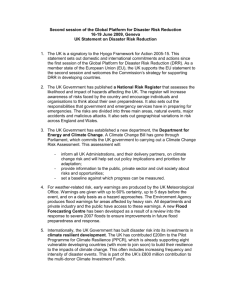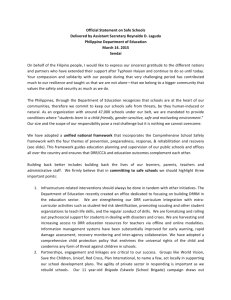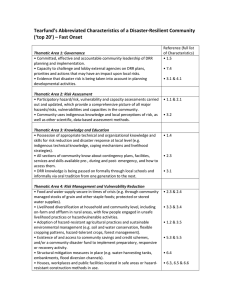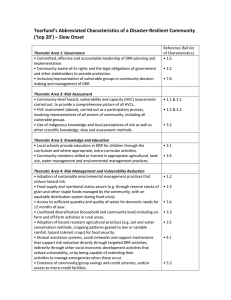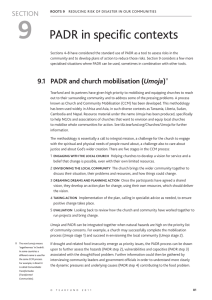Tearfund Disaster Management Key Learning Disaster Risk Reduction
advertisement
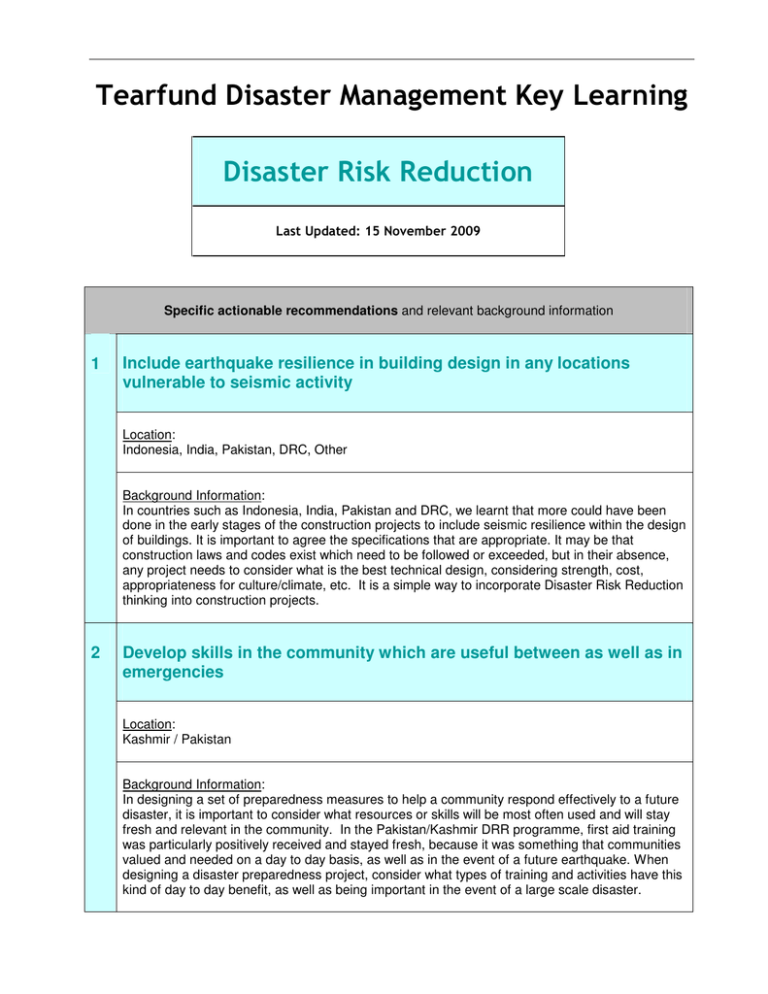
Tearfund Disaster Management Key Learning Disaster Risk Reduction Last Updated: 15 November 2009 Specific actionable recommendations and relevant background information 1 Include earthquake resilience in building design in any locations vulnerable to seismic activity Location: Indonesia, India, Pakistan, DRC, Other Background Information: In countries such as Indonesia, India, Pakistan and DRC, we learnt that more could have been done in the early stages of the construction projects to include seismic resilience within the design of buildings. It is important to agree the specifications that are appropriate. It may be that construction laws and codes exist which need to be followed or exceeded, but in their absence, any project needs to consider what is the best technical design, considering strength, cost, appropriateness for culture/climate, etc. It is a simple way to incorporate Disaster Risk Reduction thinking into construction projects. 2 Develop skills in the community which are useful between as well as in emergencies Location: Kashmir / Pakistan Background Information: In designing a set of preparedness measures to help a community respond effectively to a future disaster, it is important to consider what resources or skills will be most often used and will stay fresh and relevant in the community. In the Pakistan/Kashmir DRR programme, first aid training was particularly positively received and stayed fresh, because it was something that communities valued and needed on a day to day basis, as well as in the event of a future earthquake. When designing a disaster preparedness project, consider what types of training and activities have this kind of day to day benefit, as well as being important in the event of a large scale disaster. 3 Budget for actual project activities in follow up to any Participatory Assessment of Disaster Risk (PADR) training that is carried out Location: Sahel, Afghanistan, Other Background Information: PADR workshops should be carried out with partners and operational staff as soon as possible in the set up of a new project or partnership in a disaster-prone area. In addition to the Workshop, set aside funding for the participants to implement actual DRR activities (e.g. rainwater retention structures, tree planting or flood defences), so that practical results can be seen. Insist also upon some community contribution. Opportunities for feedback on these activities should be made available so that people can know if they are being effective. Without such funding, we have learnt that levels of motivation may drop if participants are unable to put their learning into practice. The principle applies both for staff training, and for implementing the PADR process in the villages. 4 Plan and coordinate DRR activities with governmental bodies responsible for DM Location: Various Background Information: We have learnt that planning and design of DRR activities needs to be done in conjunction with the local governmental bodies responsible for Disaster Management. This will help ensure that the government is involved from the start of the project and then supported to take ownership of any ongoing work in the longer term. 5 Make a priority of working with communities to undertake their own participatory assessment of disaster risk (PADR) process Location: Sahel / West Africa Background Information: In the experience of the Sahel response to drought, the concept of PADR was new; communities were introduced to the process of identifying their own capacities and designing actions they can take without reliance on outside organizations. The approach had a significant impact, but required close monitoring and support. 6 Consider advocacy at national level as one way of addressing local vulnerabilities, using a targeted approach on key issues, with agreed outcomes. Appoint dedicated and appropriately skilled staff for this level of advocacy and consider strategic alliances. Location: Afghanistan, India, Bangladesh & Malawi Background Information: In a DRR project across 4 countries, we learnt the importance of advocacy. At community level, advocacy was a strong success in promoting rights and entitlements, alongside facilitating communities to engage with local authorities. At the macro level, the project has engaged successfully with policy development for both donors and institutions. However, at the national level, there were initial failures to engage in relation to national government issues. The limited focus was due to a lack of dedicated policy staff within partner organisations and difficulties in gaining senior management support for advocacy activity. These recommendations also reflect the difficulty in mainstreaming DRR across ministries and policies. To ensure effective influence upon DRR policy, it is vital that competent NGOs with specific grassroots experience and skills are available to engage at a national level. It is usually necessary to develop strategic alliances with like-minded organisations. There is also the need to seek places for dialogue and interaction with national government that is pitched at the right level, for example, the vehicle of DRR National Platforms or sub-committees of DM Ministries. 7 Ensure your relief departments and development departments work and share together in order to undertake holistic DRR initiatives which draw upon the skills and experience of both. Location: Afghanistan, India, Bangladesh & Malawi Background Information: Many partners have a background in humanitarian response leading to a DRR skills set based upon disaster relief and perhaps preparedness. Often, these organisations have other departments with skills in areas such as livelihood development or micro credit, but they have been funded through different channels. Partners have recognised this and made a conscious effort to encourage their own organisational learning, developing ways of sharing between departments. In this way, community mobilisation skills, and expertise in training and awareness raising, can be drawn into the DRR work. 8 If cyclone shelters are a preferred way of ensuring safety in areas prone to cyclones & tidal surges, then they need to have adequate funding, longevity and durability, watsan facilities and take account of climate change. Location: India and Bangladesh, within DFID DRR project Background Information: Some partners had been reluctant to budget for high value items such as flood or cyclone shelters, as often they reach smaller numbers of beneficiaries. Often they had preferred to stretch resources to cover more communities in risk assessment, awareness and education. After discussion, some budgets were reshaped to support larger value construction but budgeting should also take account of ongoing maintenance needs. Tearfund has also designed tools to support decision making and identify the full breadth of risks posed by climate variability. 9 Ensure the use and maintenance of cyclone shelters between disasters is agreed so that it does not fall into disrepair Location: India and Bangladesh Background Information: Some cyclone shelters have been built in places where they are not regularly used by the community, and routine maintenance has been lacking. In saline, coastal areas, any metal fittings or exposed re-enforcing rods will be rapidly corroded. If buildings are designed for use as, for example, schools, then care and maintenance are more likely to be carried out – but budget has to be allocated for this. 10 Design of watsan infrastructure in support of recovery from a disaster should take account of future disaster risks in that area Location: Pakistan (Kashmir) and Indonesia Background Information: During the Kashmir project, water pipelines were in some cases run across small rivers supported by pillars, without adequate risk assessment. During heavy rains, flash-flooding occurred, with movement of rocks and other debris down the rivers, which damaged the pipelines. In remedial work, pipes were buried in the bed of the river, which gave them more protection. Other underground pipelines were exposed by erosion. This can be avoided by careful routing of pipes and burying them at sufficient depth. In Indonesia, all watsan installations, in particular, elevated water tanks and underground sceptic tanks, were designed with sufficient strength to withstand moderate earthquakes. 11 Food or cash-for-work projects should be chosen in a way that longterm vulnerabilities are reduced as well as short-term food and/or cash demands being met Location: Malawi, Ethiopia and Bangladesh Background Information: We have learnt the dangers of undertaking work projects which provide much needed food or cash for the workers, but the actual project has limited value (e.g. general clear-up after a cyclone). With careful thought and consultation with the community, it is usually possible to identify projects with some long-term, risk-reducing benefits – flood protection dyke, irrigation channel, pond excavation, cross-dam, water retaining “demi-loons”, terracing slopes, etc, etc. Appropriate technical input should be obtained to ensure that structures are appropriate, safe and long-lasting.

